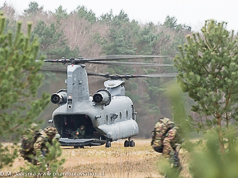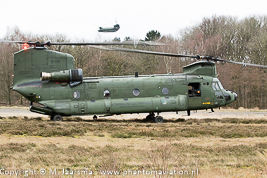
 |
|
| 11th Air Manoeuvre Brigade / Exercise Falcon Frostfire |
| Latest update: June 2016 |
The 11 Air Manoeuvre Brigade (11 AMB) is composed of the Royal Netherlands Army 11 Luchtmobiele Brigade (11 Air Mobile Brigade – 11 LM) and three squadrons of the Royal Netherlands Air Force – Defence Helicopter Command. 11 LM was founded in the early 1990s and operates from the Oranje and Johan Willem Friso barracks respectively located in Schaarsbergen and Assen. The Brigade is subdivided into the 11, 12 and 13 Infantry Battalions and 11 Engineer, Supply, Maintenance, Medical and Headquarters companies All three battalions are subdivided into companies of which one is a dedicated paratrooper company which receives specialized training. To execute its task the brigade is equipped with: DAF 4 and 10 ton trucks, Mercedes-Benz terrain vehicles , and Patria panzer vehicles, Enduro motorcycles and the air mobile special vehicles. These are used to transport communication equipment, munitions, wounded soldiers or anti-tank weapons. All 11 LM companies are specialized in air manoeuvre (air assault) operations and can deploy in a period between 7 and 20 days. In June 2014 the 11 LM became part of the German Armies Division Schnelle Kräfte (DSK – Rapid Reaction Division) and is commanded by joint German – Netherlands staff. DHC’s 298 squadron (Boeing CH-47D/F Chinook), 300 squadron (Airbus Helicopter AS532 Cougar) and 301 squadron (Boeing Defence AH-64D Apache) are the aviation assets of 11 AMB. The squadrons and 11 LM work closely together during exercises and international (EU / NATO / UN) peacekeeping- or humanitarian missions. An example of last is the current deployment supporting the United Nations MINUSMA mission in Mali where both units of 11 LM as well as three Chinook and four Apache are deployed and among other duties are supporting the Dutch special forces. Although not part of 11 AMB also 336 squadron based at Eindhoven Air Base and equipped with four Lockheed Martin C-130H / C-130H.30 Hercules transport aircraft supports 11 LM. The 11 Supply Company together with the Hercules crews are working on certifying the air drop mission. On January 7, 2016 one Hercules conducted the first airdrop in the Netherlands since WWII dropping pallets over military air base Deelen. Following this successful mission a second was flown on February 2 over Gilze-Rijen Air Base dropping four containers. By adding this new capability to the Hercules mission the crews are able to support 11 LM by resupplying them from the air which will be very useful when the Brigade is operating far behind enemy lines and ground supply routes are not established. 11 AMB is capable of performing four forms of air manoeuver: Air Assault, Air Mechanized, Air Mobile & Airborne and RAID. The Air Assault operation will see the infantry battalion operate together with the attack- and transport helicopters. The Apaches will be the first to enter the area of operations using their sensors to search for enemies and destroying targets until its safe for the transport crews to fly into the landing zone(s). During the insertions the Apaches will operate in the Close Air Support (CAS) role where they will use their sensors to locate hostile forces and engage them or the direct the ground forces. The Air Mechanized operation will see action from the Apaches. Requests for fire and directing air support can be coordinated through the forward observers and forward air controllers but the Apaches can also work independent, searching and destroying targets. These specialists are assigned to all companies and are trained to international standards enabling them to direct also aircraft and helicopters of coalition forces. The Air Mobile and Airborne mission is using the transport helicopters and aircraft. The Hercules is used to drop the paratrooper companies during Airborne mission while during the Air Mobile missions the infantry battalions are moved by Chinook and/or Cougar helicopters to or from the area of operations. The RAID mission is conducted to destroy one or more targets. The Air Mobile companies are inserted to the landing zone(s) then the transport helicopters will depart to a holding zone while the action on the ground is being conducted. As soon as the ground mission leader calls the helicopters they will return to extract the ground team(s).
From January 25 until February 5 exercise Frostfire took place. The exercise goal to train procedures and techniques covering the whole spectrum of the Air Manoeuvre mission. Over 700 soldiers from 11 LM participated in the exercise and these were joined by colleagues from other Royal Netherlands Army units as well as units from Belgium including paratroopers. During the exercise they were supported by the four squadrons introduced above. The exercise started at Gilze-Rijen Air Base with the first days of the exercise mainly aimed to train the Brigade and battalion staff responsible for planning the missions taking place in the second week. On February 1st the 11 AMB started their operations. For the morning an Airborne operation was planned seeing a Hercules depart Gilze-Rijen to drop the paratroopers over the Belgian city of Lanaken to capture two bridges. Unfortunately the weather conditions were that bad that safety regulations led to the paradrop being cancelled. The back-up scenario was set in motion which saw the paratroopers being moved by road to Lanaken where they started their operations from the ground. Meanwhile at the Air Base the crews of 298, 300 and 301 squadrons and the infantry battalions prepared for their Air Assault mission which took place in the afternoon. Their objective was to secure the airstrip of Zutendaal and set up a bridgehead for further operations taking place throughout the week. After the paratroopers captured the assigned bridges thus preventing an enemy (tank) attack towards the airstrip the green light was given for the Air Assault. The Apaches took to the air and routed to Zutendaal tasked to destroy an assigned target and perform the CAS mission. At the moment the target was destroyed and the CAS pattern established the transport helicopters comprised of two Cougars and three Chinooks started their assault at the airfield. The insertion of troops took two minutes to complete from the first helicopter to arrive and the last to leave the landing zone. Immediately after exiting the helicopters a perimeter was set-up and forces disappeared into the woods starting their operations to create a safe landing zone. When the area was cleared from enemy the second wave of transport helicopters arrived. These carried the air mobile special vehicles as sling load with two carried by the Chinook and one by the Cougar and enabled them to transport the second wave of air mobile soldiers. More reinforcements were on the way by road to train the ground move known as link-up. With the bridgehead created and building up its strength 11 LM continued its operations in Belgium supported by the DHC squadrons and as 11 AMB conducted a RAID mission on Thursday February 4 before finishing the exercise on Friday the 5th. The author would like to thank: Maj. Versteegden 11 LM head of communications, 1 Lt. Dick Hoeflaken DHC Media department. |
| Photogallery |
 |
 |
 |
 |
 |
 |
 |
 |
 |
 |
 |
 |
 |
 |
 |
|
|